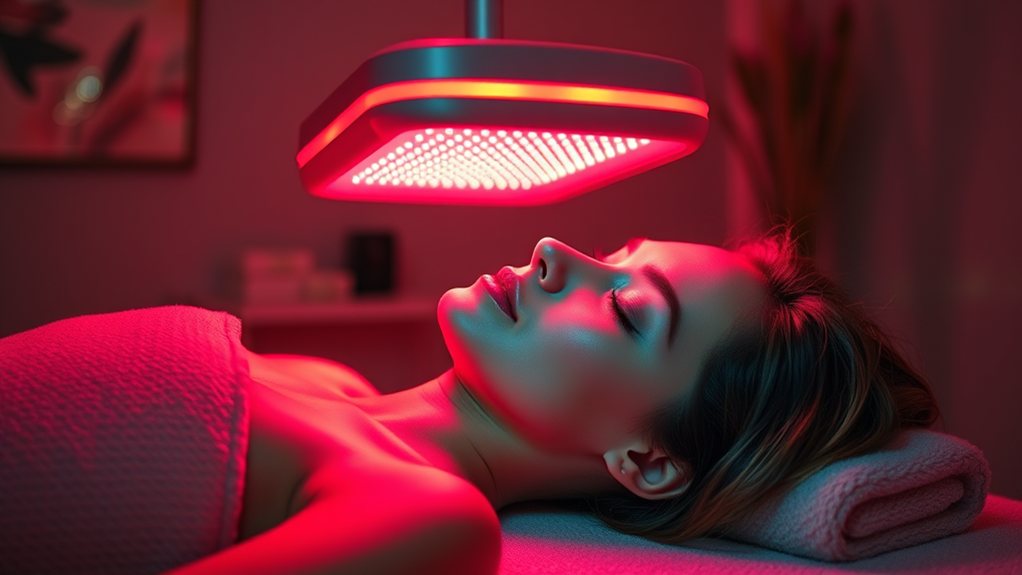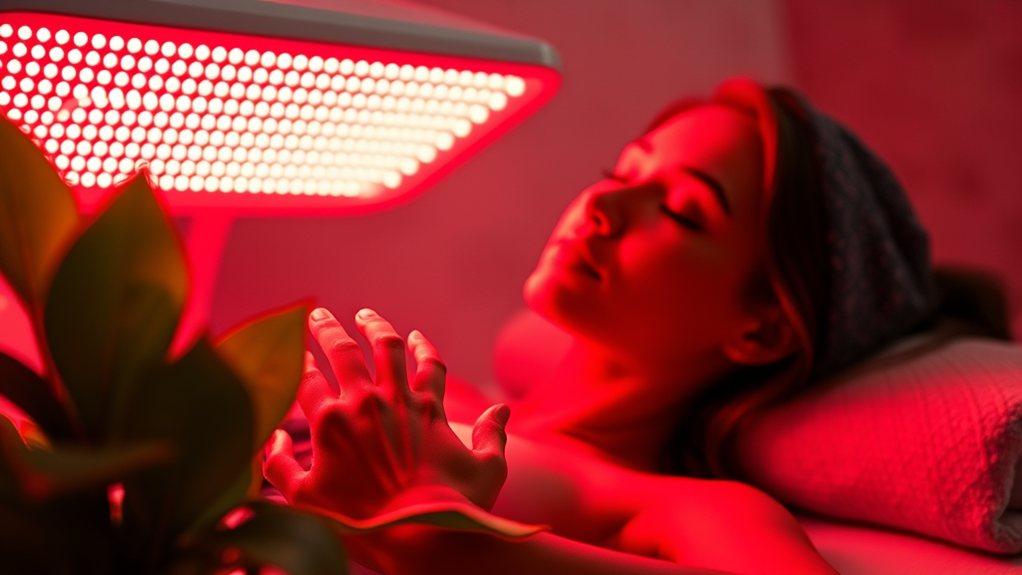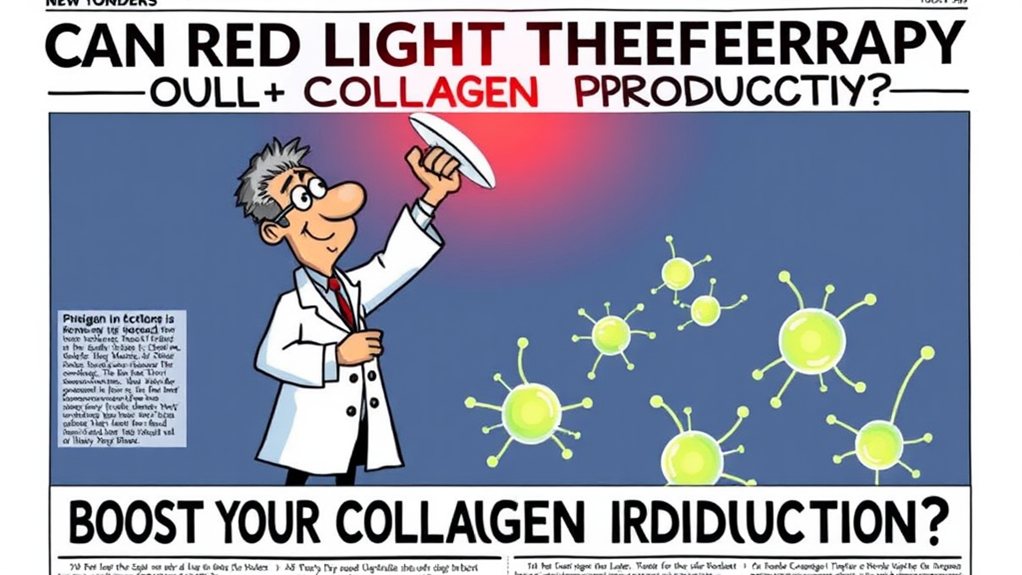Yes, red light therapy can elevate your collagen production. It utilizes specific wavelengths of light that stimulate cellular processes and improve mitochondrial activity, which promotes collagen synthesis. This non-invasive treatment reduces inflammation and enhances skin texture by increasing fibroblast activity. Many find that combining red light therapy alongside collagen supplements maximizes the benefits. If you're curious about the mechanisms or want to investigate other options, there's much more to discover in the following sections.
Key Takeaways
- Red light therapy stimulates mitochondrial activity, enhancing cellular processes that boost collagen production.
- Increased fibroblast activity from red light therapy improves skin texture and reduces fine lines.
- The treatment reduces inflammation, which can hinder collagen synthesis in the skin.
- Combining red light therapy with collagen supplements can optimize skin benefits and enhance results.
- Many users report visible improvements in skin health and elasticity after consistent red light therapy sessions.
What Is Red Light Therapy?

Red light therapy, often referred to as low-level laser therapy (LLLT), employs specific wavelengths of light for stimulating cellular processes. This non-invasive treatment harnesses the power of red light for penetrating the skin, promoting various therapy benefits.
You may experience improved collagen production, enhanced skin texture, and reduced inflammation. Research indicates that the light activates mitochondria in cells, leading to increased energy and regeneration.
Experience enhanced collagen production and reduced inflammation as red light therapy rejuvenates your skin from within.
As a result, many individuals find red light therapy beneficial for various skin concerns, such as aging and acne. By incorporating this therapy into your routine, you could foster a sense of community and belonging, as many share their positive experiences and outcomes.
Embracing red light therapy could be a transformative step toward healthier skin.
How Does Red Light Therapy Work?
Utilizing specific wavelengths of light, red light therapy stimulates various biological processes in the skin. The therapy primarily employs wavelengths between 600 and 1000 nanometers, known for their effective penetration.
This targeted approach triggers a cellular response, enhancing mitochondrial activity within skin cells. As a result, your skin's energy production increases, leading to improved tissue repair and regeneration.
The wavelength effects also promote blood circulation, which delivers important nutrients and oxygen, further supporting skin health. By harnessing these benefits, red light therapy encourages the synthesis of collagen and elastin, critical proteins for maintaining skin structure and elasticity.
As you incorporate red light therapy into your routine, you're not just treating your skin; you're actively engaging in its health and resilience.
The Role of Collagen in Skin Health

Collagen serves as the backbone of skin health, providing structure, elasticity, and strength. As you age, collagen production naturally declines, leading to visible signs of aging such as wrinkles and sagging skin.
Understanding the collagen benefits can empower you to take proactive steps in maintaining your skin's liveliness. Improved skin elasticity is one of the most significant advantages of adequate collagen levels, allowing your skin to stretch and bounce back more effectively.
By supporting collagen synthesis through various methods, including diet and treatments like red light therapy, you can promote a youthful appearance and enhance overall skin texture.
Embracing these practices fosters a sense of community around skincare, helping you feel more connected to others who prioritize their skin health.
The Science Behind Collagen Production
As your skin ages, understanding the biochemical processes involved in collagen production becomes crucial for maintaining its health.
Collagen synthesis occurs primarily in fibroblasts, which are specialized cells that produce collagen and other extracellular matrix components. This process is influenced by various factors, including age, nutrition, and hormonal changes.
When collagen levels decline, skin elasticity diminishes, leading to wrinkles and sagging. The body naturally slows collagen production as you age, highlighting the significance of strategies to support its synthesis.
Incorporating nutrients like vitamin C and amino acids can help stimulate fibroblast activity, promoting healthier skin.
Evidence Supporting Red Light Therapy and Collagen

Research indicates that red light therapy (RLT) can significantly improve collagen production in the skin. Studies have shown that specific light wavelengths, particularly in the red and near-infrared spectrum, stimulate collagen synthesis effectively. This process not only boosts skin elasticity but also promotes a youthful appearance.
Here are some key findings supporting RLT's efficacy:
- Increases fibroblast activity, essential for collagen production
- Promotes healing of damaged skin, improving collagen output
- Reduces inflammation, which can hinder collagen synthesis
- Improves skin texture and reduces fine lines through increased collagen
- Supports overall skin health by increasing hydration and elasticity
How to Incorporate Red Light Therapy Into Your Routine
How can you effectively integrate red light therapy (RLT) into your daily skincare routine?
Start by selecting a high-quality home device designed for facial use. Aim for 10-20 minute sessions, ideally on clean, dry skin, several times a week.
Consistency is key, so schedule your RLT sessions just like you'd any other skincare step. If you're seeking faster results, think about complementing your home routine alongside professional treatments.
These sessions often use more powerful devices, providing deeper penetration and improved collagen stimulation. Remember to monitor your skin's response and adjust frequency as needed.
Potential Side Effects and Considerations
While red light therapy (RLT) is generally regarded as safe for most individuals, it's important to be aware of potential side effects and factors before incorporating it into your routine.
Here are some safety precautions for keeping in mind:
- Skin irritation or redness
- Eye safety concerns if not properly shielded
- Overuse leading to potential burns
- Individuals alongside specific medical conditions (e.g., epilepsy) should consult a healthcare provider
- Pregnant individuals should seek professional advice prior to use
Comparing Red Light Therapy to Other Collagen-Boosting Treatments
When evaluating collagen-boosting treatments, it's vital to compare red light therapy alongside other popular options, such as microneedling, chemical peels, and laser therapy.
Red light therapy promotes collagen production non-invasively, making it appealing for those seeking minimal downtime.
In a microneedling comparison, this method involves tiny needles to stimulate collagen but may require recovery time and carries a risk of infection.
On the other hand, laser treatments can effectively improve skin texture and firmness but often involve discomfort and longer recovery periods.
Each treatment has its unique benefits and potential drawbacks, so it's important to reflect on your individual skin type and goals when choosing the right collagen-boosting solution for you.
Personal Experiences and Testimonials
Many individuals who've undergone red light therapy report noticeable improvements in their skin's appearance and texture, often citing heightened collagen production as a key benefit.
Red light therapy users often highlight remarkable enhancements in skin texture and appearance, particularly due to increased collagen production.
These personal stories and user experiences highlight the therapy's potential effectiveness.
- Increased skin elasticity
- Reduced fine lines and wrinkles
- Enhanced overall skin tone
- Faster healing of blemishes
- A more youthful, radiant appearance
Participants frequently express satisfaction, noting how these changes have positively impacted their confidence and self-esteem.
Scientific studies support these claims, indicating that red light therapy can stimulate fibroblast activity, leading to increased collagen synthesis.
Final Thoughts on Red Light Therapy for Collagen Production
As research continues in validating the benefits of red light therapy, it's clear that this treatment offers a promising avenue for enhancing collagen production and improving skin health.
By integrating red light therapy into your skincare routines, you could potentially experience firmer and more youthful skin. While collagen supplements can support your skin from within, red light therapy directly stimulates collagen synthesis at the cellular level, offering a complementary approach.
Many individuals find that combining these methods yields the best results. It's crucial to consult alongside a healthcare professional to tailor a regimen that suits your specific needs.
Embracing red light therapy could be the key to achieving the radiant skin you desire, fostering a sense of confidence and belonging in your skincare journey.
Frequently Asked Questions
How Long Does It Take to See Results From Red Light Therapy?
You'll typically notice initial results from red light therapy within a few weeks, but a consistent treatment schedule is essential for ideal effects. A results timeline varies, often improving through continued sessions and adherence to recommendations.
Can Red Light Therapy Be Used on All Skin Types?
Yes, red light therapy shows skin type compatibility across various individuals. However, your individual response may vary. Consulting with a professional can help tailor the treatment for your specific skin needs for best results.
Is Red Light Therapy Safe for Sensitive Skin?
Yes, red light therapy can be safe for sensitive skin, but you should take treatment precautions. Monitor for any skin reactions and consult a professional in order to tailor the therapy for your specific skin needs.
How Often Should I Undergo Red Light Therapy Sessions?
Imagine basking in gentle sunlight; for best results, aim for sessions two to three times weekly. Follow frequency guidelines and maintain consistent treatment intervals to improve your skin's health and rejuvenation journey effectively.
Are There Any Age Restrictions for Using Red Light Therapy?
There aren't strict age restrictions for red light therapy, but pediatric factors apply. It's advisable for children to consult a healthcare professional prior to starting treatments, ensuring age suitability and safety for their developing bodies.
Conclusion
To sum up, red light therapy shows promise in boosting collagen production, which can improve skin health and appearance. For instance, a hypothetical case study of a 45-year-old woman undergoing a 12-week red light therapy regimen revealed a noticeable reduction in fine lines and enhanced skin elasticity. By incorporating this therapy into your skincare routine, you may experience similar benefits, supported by emerging evidence and positive testimonials. Always consult with a healthcare professional prior to starting any new treatment.
